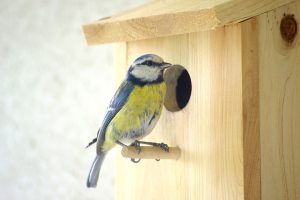We are a nation of animal lovers; most of us who have pets also want to care for our feathered friends.
Many people wonder if birds will visit a garden with a dog or cat, and whether they’re wasting their time and money attempting to feed them.
Unless you have a tiger that lives 24/7 in your garden, it is almost always worth feeding the birds.
Some species are relatively fearless and swoop in when your cat or dog has their back turned.
Others are patient and find a good vantage point to sit and wait until the pet goes back indoors.
Cats are only doing what comes naturally to them. They are a few hints you can use to prevent your garden birds from becoming prey for your domestic hunters.
Hints for safely feeding the birds in gardens with pets
Table of Contents
Pole Feeders
The best way to feed the birds is up high, where pets can’t reach them. Consider where you place the feeder as it needs to be close to cover so that sparrowhawks can’t spot the feeding birds. There is also a place of safety for the bird to head to when it feels threatened.
When birds feed on high, there will undoubtedly be an overspill of seed and suet on the ground. The ground-feeding birds might be attracted to this and put themselves in harm’s way.

To avoid this happening, plant prickly plants around the base of the table, nowhere for a predator to hide or a bird to land.
Bird feeders with trays are the best option; they catch any excess food. Just ensure that the tray is at a decent height, around 1.2m should do it.
Ground feeders
Our friends, the robin, dunnock, and blackbird love to find their food at ground level though it leaves them open to attack from pets.
If you intend to offer ground feed, try to place it in an open space, at least 3m from any cover. That way, the bird has sufficient time to flee before a cat can pounce or a dog run to it.
Prickly plants dotted amongst vegetation and flower birds ensure cats have no hiding place.
Safety in numbers
Cats and small dogs are often intimidated by large flocks of birds. If you keep your feeders well-stocked with a variety of foods, you should encourage larger numbers of birds.
The birds feel safe as part of a crowd and act as each other’s early warning system should a dog or cat be approaching.
Where to safely position nesting boxes
It takes careful planning as boxes need to be out of reach of sneaky and lithe cats.
Being at height isn’t enough; cats climb.
Planting thorny bushes at their bases is a good deterrent as cats have no way to lunge. Some plants such as pyracantha and hawthorn are beneficial in other ways; they provide berries to complement bird’s diets during autumn and winter.
Cats dislike citronella; planting it in bird-feeding zones should deter the cats, and hopefully, the wasps as well.
The time that pets provide the worst threat is when the young birds are ready to fledge.

Before they fully gain their flying wings, they spend much of their time on the ground.
It is advisable to keep your pets indoors during this time though that might not be possible.
Statistics show that most fledglings get lost to predators at dawn and dusk, so keeping your animals indoors at those times helps.
Owning an outdoor cat and hanging nesting boxes is a lot of additional work. If you can’t manage to keep your cat indoors, you might be better off sticking to feeding the birds.
Early warning
If your pet can stand it, a collar with a small bell attached is the ideal way to let feeding birds know that they aren’t alone.
Final thoughts
When the weather changes and temperatures drop, we should continue to feed the birds, even if we have pets.
Birds will visit a garden that has dogs and cats if there’s enough food to attract them there.
If we follow a few simple guidelines, we can ensure that they remain well-fed, stay safe, and leave our gardens in one piece.
